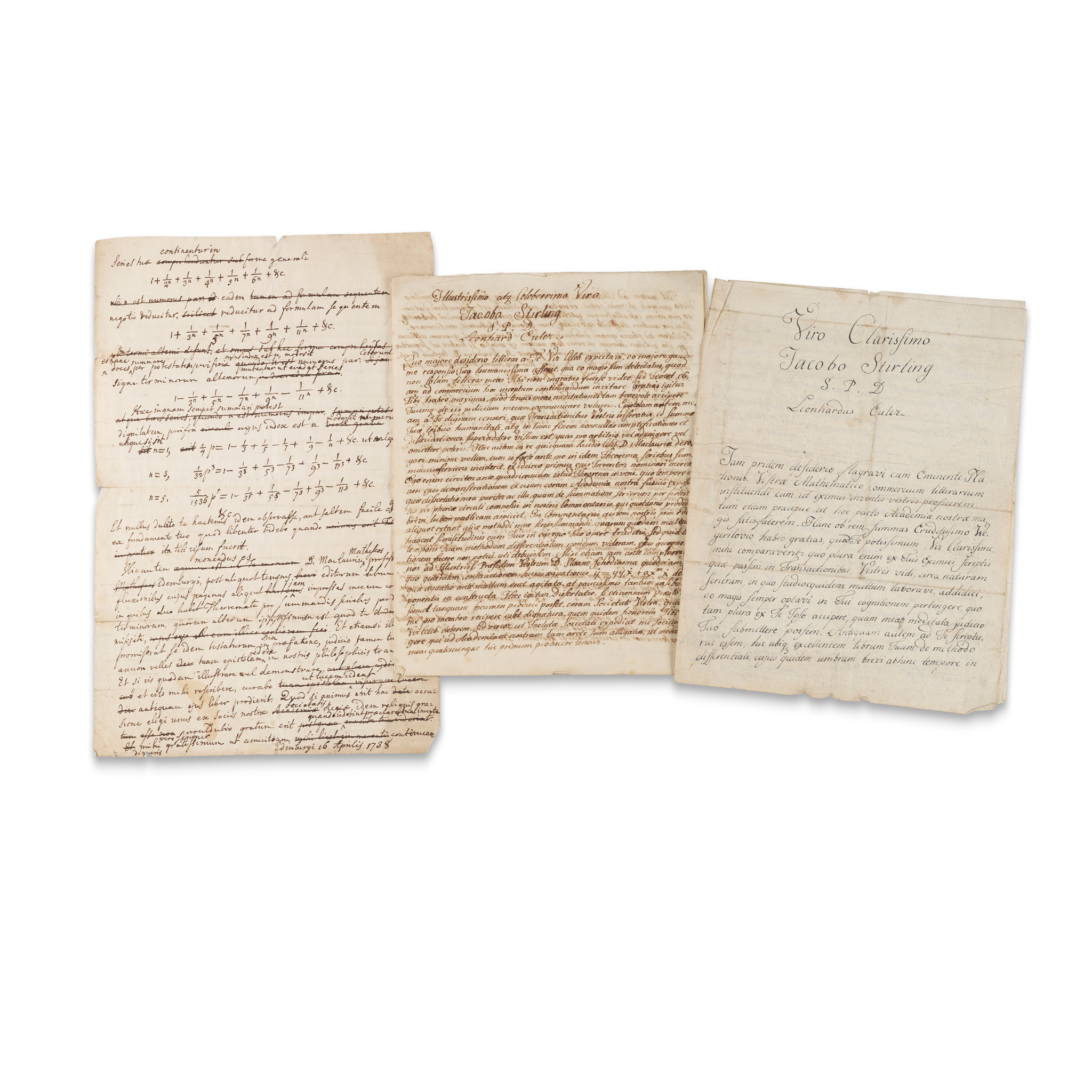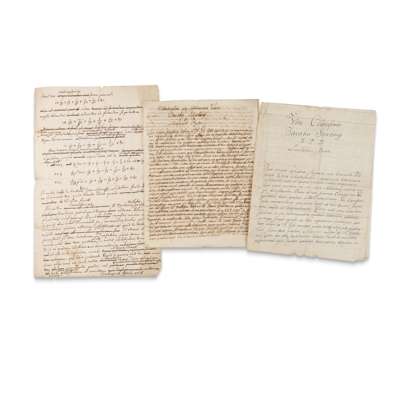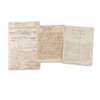
Lot 20

Euler, Leonhard (1707-1783)
Two autograph letters signed to James Stirling


The Library of James Stirling, Mathematician
Auction: 23 October 2025 from 13:00 GMT
Description
First letter: dated Petropoli [i.e. St Petersburg], 8th June 1736, 4 pp., in Latin, addressed and signed at head ‘Viro Clarissimo Jacobo Stirling S. P. D., Leonhardus Eule’, professing admiration of Stirling's work on the nature of series as published in the 'Transactions' (i.e. of the Royal Society) and 'Your excellent book, Methodus differentialis' ('excellentem librum tuum de methodo differentiali'), in particular part I proposition XIV, and providing an extensive demonstration of his (Euler's) own method of the summation of very slowly converging series, as read before the Russian Academy of Sciences ('Quod quidem ad summationem serierum lentissime convergentium attinct, ego praeteriot anno quoque coram Cademia nostra methodum peculiarem praelegi, cujus ope plurium serierum exiguo labora summas satis prope dedi'), 18.5 x 24cm.
Second letter: dated Petropoli, 27th July 1738, in Latin, 8 pp. addressed and signed at head ‘Viro Clarissimo Jacobo Stirling S. P. D. Leonhardus Euler’, principally on series, with extensive demonstrations (see below), 18 x 24cm.
Together with James Stirling's autograph draft response to Euler's first letter, with corrections, dated Edinburgh, 16th April 1738, 2 pp., in Latin, 30.4 x 19.6cm, splits and nicks to edges (especially at folds) (3)
Footnote
A major collection of letters identified by Charles Tweedie, editor of the correspondence of James Stirling, as evidence of the independent discovery of the Euler-Maclaurin theorem by its two namesakes. Included is Leonhard Euler's first letter to James Stirling, which initiated their acquaintance and was shown by Stirling to Maclaurin, who consequently referred to it in the second volume of A Treatise of Fluxions. Tweedie contrived not to see Euler's first letter of 1736 and consequently believed it to be lost, though he inferred its existence from Stirling's reply and an ambiguous reference to a secondary source which cites a letter from Euler to Stirling dated 9th June 1736; it was eventually rediscovered in the 1980s by historian of mathematics Ian Tweddle.
In Stirling's draft response, much delayed presumably owing to his work at Leadhills, he professes himself most pleased with Euler's theorem of the summation of series ('Gratissimum mihi fuit theorema tuum pro summandis seriebus …') and concedes that his own theorem for summing logarithms is only a particular case. He then 'informs Euler that Maclaurin has an identical theorem in the proof-sheets of a Treatise of Fluxions to appear shortly. At the same time he offers to communicate Euler's results to the Royal Society, and suggests that Euler should become a Fellow' (Tweedie, p. 212). Euler, in his lengthy response, replete with demonstrations, waives his claim to priority over Maclaurin ('he probably came upon the same theorem for summing series before me, and consequently deserved to be named as its first discoverer': Tweddle's translation), proposes that the society publish his paper on the Riccati equation, sent to Hans Sloane a few years previously, and communicates a unique proof sent by Nicolaus Bernoulli, among other matters.
Maclaurin's acknowledgment of Euler's initial letter comes in a footnote to the fifth chapter of the second volume of A Treatise of Fluxions (1742), the chapter headed ‘Of interpolating the intermediate terms of a series’: ‘I take this opportunity to mention, that having occasionally shewn in 1737 [in the first volume of Fluxions], the 292, 293 pages of this treatise (after they were printed) to Mr. Stirling, he took notice that a theorem similar to the first as these described in art. 352 had been communicated to him by Mr. Euler’.
Published:
Charles Tweedie, James Stirling: A Sketch of his Life and Works along with his Scientific Correspondence, 1922, pp. 178-191 (Euler's letter of 1738 and Stirling's draft response only).
Ian Tweddle, James Stirling: ‘This about Series and Such Things’, A Discussion of the Later Works of Scottish Mathematician James Stirling (1692-1770), based mainly on Material from his Notebooks, 1988, pp. 141-154 (all three letters, with Euler's translated into English).

